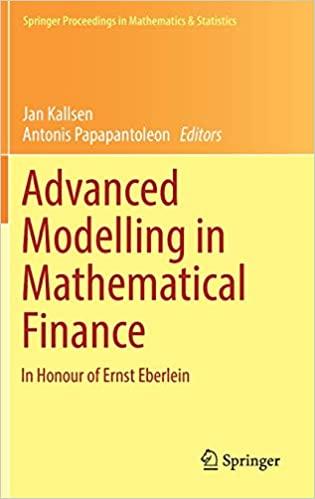Question
1. Ed Lawrence has invested $100,000. Of that, $30,000 is invested in IBM stock, $25,000 is invested in T-bills, and the remainder is invested in
1. Ed Lawrence has invested $100,000. Of that, $30,000 is invested in IBM stock, $25,000 is invested in T-bills, and the remainder is invested in corporate bonds. Which of the following is true regarding his portfolio?
a. Ed has 30% of his portfolio invested in stocks.
b. Ed has 55% of his portfolio invested in corporate bonds.
c. If IBM has a beta less than one, the portfolio must have a beta greater than one.
d. Ed has 70% of his portfolio invested in risk-free assets.
e. Changes in the return on IBM stock will have the greatest impact on changes in the portfolio return.
2. Given the following information, what is the WACC?
Common Stock: 1 million shares outstanding, $40 per share, $1 par value, beta = 1.3 Bonds: 10,000 bonds outstanding, $1,000 face value each, 8% annual coupon, 22 years to maturity, market price = $1,101.23 per bond Market risk premium = 8.6%, risk-free rate = 4.5%, marginal tax rate = 34%
a. 13.30% b. 13.43% c. 13.48% d. 13.82% e. None of the above
3. The standard deviation for historical stock returns can be calculated as:
a. The square root of the average return.
b. The average difference between the actual return and the average return.
c. The square root of the variance.
d. The average return divided by N minus one, where N is the number of returns.
e. The variance squared.
4. Regarding diversification, _____________________________.
a. most of the benefits are realized with about 20 to 30 stocks
b. it is the process of increasing the riskiness associated with individual assets by spreading an investment across numerous assets
c. the portfolio returns are reduced, and the standard deviation of that portfolio remains unchanged
d. there is no limit to the amount of risk that can be eliminated through this process
e. None of the above
5. From 1925 to 2000, which of following investments has provided the largest average return?
a. Small company stocks
b. Common stocks
c. Treasury bills
d. Treasury bonds
e. Corporate bonds
Step by Step Solution
There are 3 Steps involved in it
Step: 1

Get Instant Access to Expert-Tailored Solutions
See step-by-step solutions with expert insights and AI powered tools for academic success
Step: 2

Step: 3

Ace Your Homework with AI
Get the answers you need in no time with our AI-driven, step-by-step assistance
Get Started


